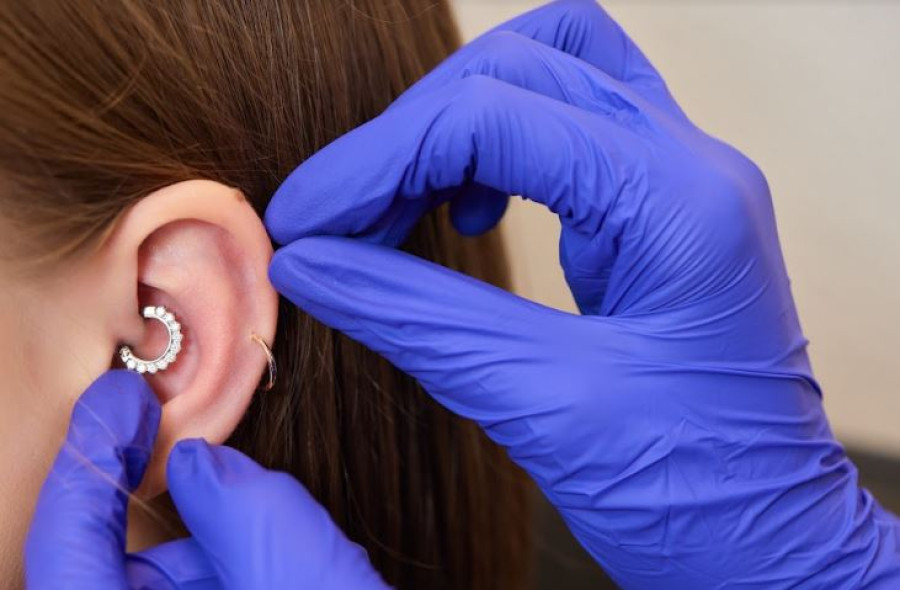Culture & Lifestyle
Preventing blisters and infections around piercings
Dermatologist Sabin Kandel explains the causes of irritation blisters around piercings and ways of preventing them.
Rishika Dhakal
Sabin Kandel, a consultant dermatologist at Maya Metro Hospital, Dhangadi, discusses the causes and prevention of blisters around piercing areas.
How can irritation blisters develop around piercings, and what causes them?
Irritation blisters around piercings typically form due to friction, pressure, or an allergic reaction. When jewellery rubs against the skin or is too tight, it can cause micro-separation between skin layers, causing blisters.
Additionally, if the metal in the jewellery contains allergens (like nickel, the most common allergen among metals), the skin may react by dilation of blood vessels and microleakage, forming blisters. These blisters act as the body's protective response, shielding the irritated area and preventing further damage.
What are the signs that a piercing is infected versus simply irritated?
Irritation around a piercing usually causes mild redness, slight discomfort and sometimes blisters, with clear fluid but no pus or fever. In contrast, infection causes more severe symptoms, including worsening redness and swelling with severe pain and critical signs such as pus with an unpleasant odour, warmth around the area, and possibly fever or general unwellness. To differentiate between infection and irritation, the infection has more intense symptoms. In contrast, irritation shows mild discomfort without severe pain or discharge around the piercing site.

What materials or metals should people avoid if they have sensitive skin or are prone to irritation blisters?
People with sensitive skin or who quickly get irritation blisters should avoid metals like nickel. Nickel is commonly used in jewellery and is one of the leading causes of allergic reactions. Other metals to avoid include cobalt and brass, which can irritate skin.
Nickel is commonly used in metals plated with gold or silver. Many people who believe they are allergic to gold or silver jewellery react to the nickel present in trace amounts or used to strengthen the jewellery.
Safer alternatives include hypoallergenic metals like titanium, platinum, surgical-grade stainless steel, and 18-karat or higher gold (avoid gold-plated items). These metals are much less likely to cause irritation or allergic reactions.
What are the best aftercare practices to prevent irritation or blistering around new piercings?
To take care of your new piercing and prevent infection or irritation, follow these easy steps:
Choose a Qualified Piercer: To minimise irritation, ensure your piercing is done by a professional who uses hypoallergenic jewellery, such as titanium or surgical-grade stainless steel.
Prioritise Cleanliness: Always wash your hands before touching the piercing to prevent transferring bacteria. Gently clean the piercing daily using a mild, fragrance-free soap and water and rinse thoroughly to remove all the soap. Alternatively, use a saline solution if available.
Moisturise appropriately: Keep the piercing moist by applying a thin layer of petroleum jelly around the piercing to keep the skin moist and speed up healing.
Avoid harsh products: Avoid antibacterial soaps, alcohol-based solutions, and sterilising products, as they can dry out or irritate the skin.
Are there any recommended medical treatments if people develop a blister or keloid near their piercing?
Yes, there are medical treatments available for post-piercing blisters or keloids:
Initial Care: Start by gently cleaning the affected area as advised above. Avoid using harsh chemicals and popping the blisters, as these increase the risk of infection and healing.
Topical Antibiotics: If the blister appears inflamed or infected, applying topical antibiotics such as mupirocin or fusidic acid around the piercing (while avoiding direct occlusion of the hole) can help prevent infection and allow drainage.
Oral Antibiotics: In cases of significant swelling, redness, or purulent discharge, oral antibiotics may be prescribed for a few days to a week to control the infection.
Corticosteroids: Short-term use of topical corticosteroids may reduce inflammation in cases of persistent irritation or signs of allergic reactions. However, in some cases, temporarily stopping wearing the jewellery may be necessary.
How can individuals with existing skin conditions such as eczema or psoriasis safely get piercings without triggering flare-ups?
For individuals with eczema or psoriasis, getting a piercing is possible by taking the proper precautions. The key is choosing hypoallergenic jewellery made from materials that are less likely to trigger skin reactions. Selecting a piercing site that isn’t prone to flare-ups in conditions like psoriasis and other skin disorders is also essential. Similarly, for conditions like psoriasis, be aware of Koebner’s phenomenon, where trauma to the skin can trigger new lesions. If an individual has previously experienced this or has active lesions at the desired piercing site, it is best to choose a different area or reconsider after consulting your dermatologist.
Similarly, timing is crucial when getting a piercing with skin conditions like eczema or psoriasis. Avoid getting pierced during an active flare-up, and make sure your skin is calm and well-controlled with prescribed treatments beforehand.
Proper aftercare is essential. Lastly, if you notice redness, swelling, or itching, consult your dermatologist immediately to prevent complications.




 15.47°C Kathmandu
15.47°C Kathmandu















